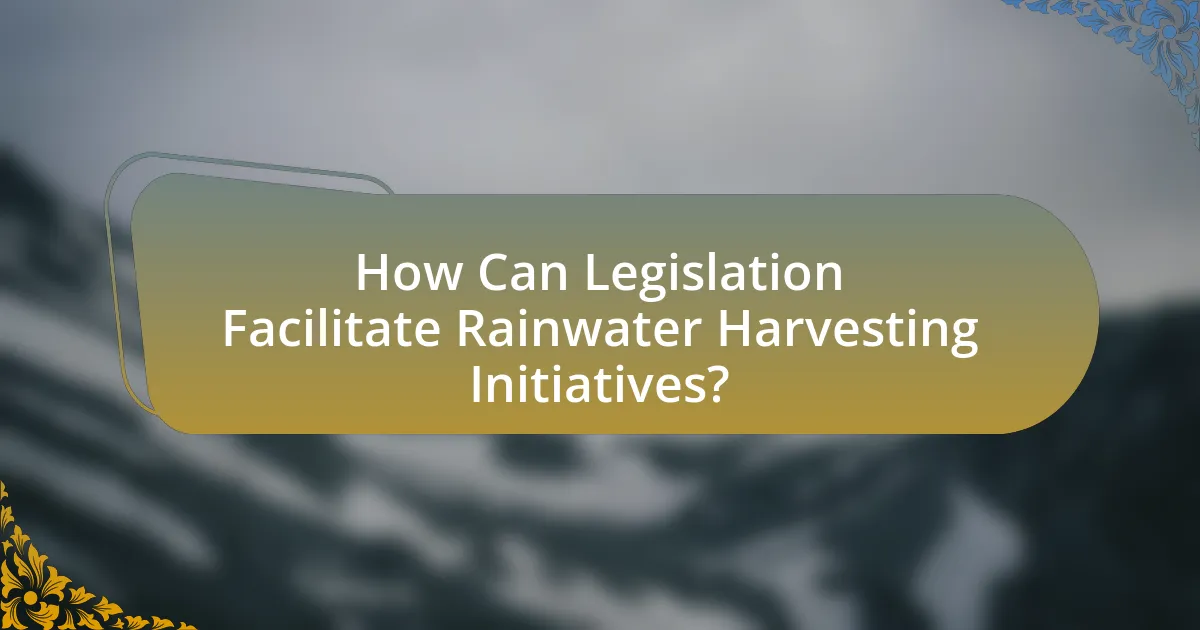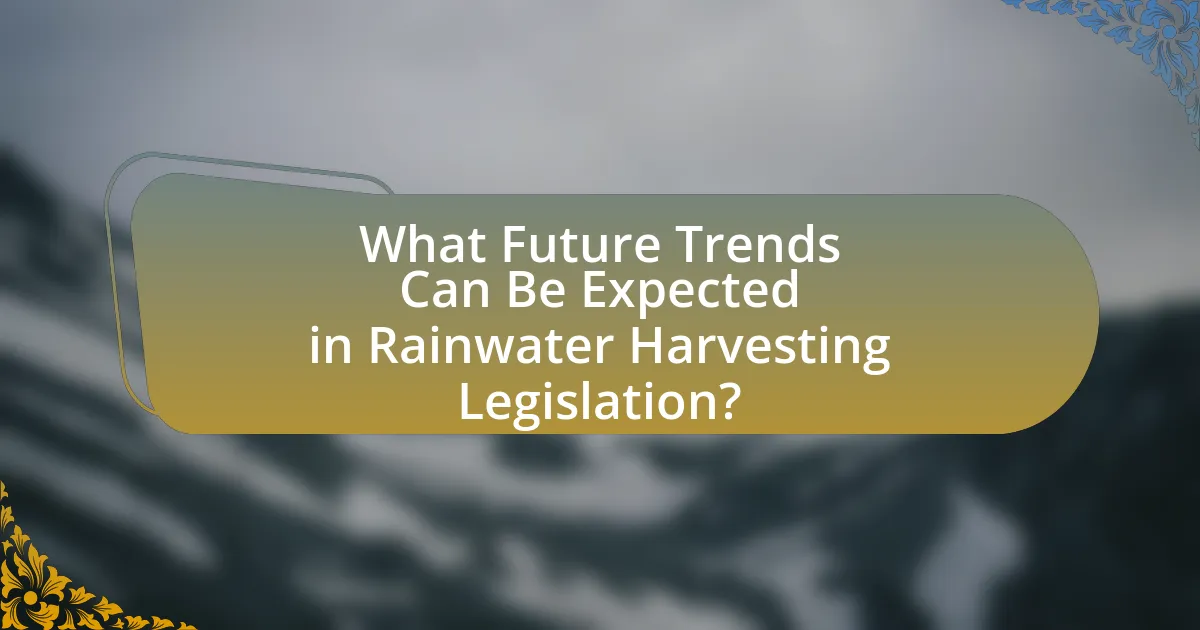Legislation plays a critical role in facilitating rainwater harvesting initiatives by establishing guidelines, incentives, and regulations that promote the adoption of these systems. Key types of supportive legislation include building codes, water conservation laws, and financial incentives such as tax credits. Local and state regulations significantly impact the implementation of rainwater harvesting practices, influencing public awareness and participation. Effective legislation not only enhances water conservation efforts but also addresses economic implications, challenges, and misconceptions surrounding rainwater harvesting. The article explores successful examples of legislation globally, the role of stakeholders, and future trends influenced by climate change and technological innovations in water management.

How Can Legislation Facilitate Rainwater Harvesting Initiatives?
Legislation can facilitate rainwater harvesting initiatives by establishing clear guidelines and incentives for implementation. For instance, laws can mandate the installation of rainwater harvesting systems in new buildings, thereby increasing adoption rates. Additionally, financial incentives such as tax credits or grants can encourage property owners to invest in these systems, as seen in various states where such policies have led to a significant increase in rainwater collection. Furthermore, legislation can ensure that collected rainwater is regulated for safe use, which enhances public trust and participation in these initiatives.
What types of legislation support rainwater harvesting?
Legislation that supports rainwater harvesting includes building codes, water conservation laws, and tax incentives. Building codes often mandate the inclusion of rainwater harvesting systems in new constructions, ensuring compliance with safety and environmental standards. Water conservation laws promote the use of alternative water sources, including rainwater, to reduce demand on municipal supplies. Tax incentives, such as rebates or deductions for installing rainwater systems, encourage homeowners and businesses to invest in these sustainable practices. For example, states like California and Texas have enacted specific laws that facilitate and incentivize rainwater harvesting, demonstrating a commitment to water resource management and sustainability.
How do local laws impact rainwater harvesting practices?
Local laws significantly influence rainwater harvesting practices by establishing regulations that dictate the legality, design, and implementation of such systems. For instance, some jurisdictions may require permits for rainwater harvesting installations, while others may offer incentives like tax credits or rebates to encourage adoption. According to a study by the American Rainwater Catchment Systems Association, areas with supportive legislation see a higher rate of rainwater harvesting adoption, demonstrating that clear legal frameworks can enhance community engagement and compliance.
What role do state regulations play in promoting rainwater harvesting?
State regulations play a crucial role in promoting rainwater harvesting by establishing legal frameworks that incentivize its adoption and implementation. These regulations often include guidelines for system design, installation standards, and maintenance practices, ensuring safety and efficiency. For instance, states like California have enacted laws that provide tax credits and rebates for homeowners who install rainwater harvesting systems, significantly increasing participation rates. Additionally, regulations can mandate the use of rainwater harvesting in new construction projects, further integrating this practice into urban planning. Such measures not only enhance water conservation efforts but also contribute to sustainable water management strategies, demonstrating the effectiveness of regulatory frameworks in fostering rainwater harvesting initiatives.
Why is legislative support crucial for rainwater harvesting initiatives?
Legislative support is crucial for rainwater harvesting initiatives because it establishes a legal framework that encourages implementation and compliance. Effective legislation can provide incentives such as tax breaks or grants, which motivate individuals and organizations to invest in rainwater harvesting systems. For instance, states like California have enacted laws that promote rainwater capture, resulting in increased adoption rates and improved water conservation efforts. Additionally, legislation can set standards for system design and maintenance, ensuring safety and efficiency, which further enhances public trust and participation in these initiatives.
How does legislation influence public awareness and participation?
Legislation influences public awareness and participation by establishing frameworks that promote understanding and engagement in specific initiatives, such as rainwater harvesting. For instance, laws that mandate educational programs about the benefits of rainwater harvesting can significantly increase community knowledge and involvement. Research indicates that regions with supportive legislation see higher rates of public participation in environmental initiatives, as evidenced by a study from the Environmental Protection Agency, which found that communities with clear regulatory guidelines on water conservation experienced a 30% increase in participation in related programs. This demonstrates that effective legislation not only informs the public but also encourages active involvement in sustainable practices.
What are the economic implications of supportive legislation?
Supportive legislation for rainwater harvesting initiatives can lead to significant economic benefits, including reduced water costs and increased investment in sustainable infrastructure. By incentivizing the adoption of rainwater harvesting systems, such legislation can lower municipal water demand, resulting in decreased operational costs for water treatment and distribution. For instance, a study by the American Society of Civil Engineers found that implementing rainwater harvesting can reduce urban water supply costs by up to 30%. Additionally, supportive legislation can stimulate job creation in the green technology sector, as businesses expand to meet the growing demand for rainwater harvesting systems and services. This dual impact of cost savings and job creation illustrates the positive economic implications of supportive legislation in promoting sustainable water management practices.
What challenges do legislators face in promoting rainwater harvesting?
Legislators face several challenges in promoting rainwater harvesting, including public awareness, regulatory frameworks, and funding issues. Public awareness is often low, leading to resistance or lack of interest in adopting rainwater harvesting systems. Additionally, existing regulatory frameworks may not support or may even hinder the implementation of such initiatives, creating legal barriers. Funding is another significant challenge, as legislators must secure financial resources for infrastructure development and public education campaigns. According to a study by the National Research Council, effective rainwater harvesting policies require comprehensive planning and community engagement to overcome these obstacles.
How can public opposition affect legislative efforts?
Public opposition can significantly hinder legislative efforts by creating pressure on lawmakers to reconsider or abandon proposed policies. When constituents express strong disapproval, elected officials may fear losing support in future elections, leading them to prioritize public sentiment over legislative agendas. For instance, in 2013, public backlash against a proposed water management bill in California resulted in lawmakers withdrawing the legislation due to widespread protests and negative media coverage. This demonstrates that public opposition can directly influence the legislative process by compelling legislators to align their actions with the views of their constituents.
What are the common misconceptions about rainwater harvesting legislation?
Common misconceptions about rainwater harvesting legislation include the belief that it is illegal in many areas, that it requires extensive permits, and that it poses health risks. In reality, rainwater harvesting is legal in most regions, with many states actively promoting it through incentives and supportive laws. Additionally, while some jurisdictions may require permits, the process is often straightforward and designed to encourage sustainable practices. Health risks are typically minimal when proper collection and filtration methods are employed, as outlined by guidelines from organizations such as the Centers for Disease Control and Prevention.

How Do Successful Rainwater Harvesting Policies Look?
Successful rainwater harvesting policies are characterized by clear regulations, incentives for implementation, and comprehensive public education programs. These policies typically include guidelines for system design, installation, and maintenance, ensuring safety and efficiency. For instance, jurisdictions like California have enacted laws that allow homeowners to collect rainwater, providing tax credits and rebates to encourage adoption. Additionally, successful policies often integrate rainwater harvesting into broader water management strategies, addressing issues like drought resilience and urban runoff. Evidence of effectiveness can be seen in cities that have significantly increased their water supply through such initiatives, demonstrating the tangible benefits of well-structured policies.
What are the key components of effective rainwater harvesting legislation?
Effective rainwater harvesting legislation includes clear definitions, regulatory frameworks, incentives for adoption, and guidelines for system design and maintenance. Clear definitions establish what constitutes rainwater harvesting and the types of systems allowed, ensuring compliance and understanding among stakeholders. Regulatory frameworks provide the legal basis for implementation, outlining responsibilities for property owners and local authorities. Incentives, such as tax breaks or subsidies, encourage investment in rainwater harvesting systems, making them more accessible. Guidelines for system design and maintenance ensure that installations are safe, efficient, and environmentally sound, promoting sustainable practices. These components collectively support the successful implementation and growth of rainwater harvesting initiatives.
How do incentives and subsidies enhance rainwater harvesting initiatives?
Incentives and subsidies significantly enhance rainwater harvesting initiatives by reducing the financial burden on individuals and organizations implementing these systems. Financial incentives, such as tax credits or direct grants, encourage investment in rainwater harvesting technologies, making them more accessible. For instance, a study by the National Research Council found that states offering financial incentives saw a 30% increase in the adoption of rainwater harvesting systems compared to those without such programs. Additionally, subsidies for materials and installation further lower upfront costs, promoting widespread adoption and contributing to water conservation efforts.
What enforcement mechanisms are necessary for compliance?
Effective enforcement mechanisms necessary for compliance with rainwater harvesting legislation include regular inspections, penalties for non-compliance, and public reporting systems. Regular inspections ensure adherence to established guidelines, while penalties serve as a deterrent against violations, reinforcing the importance of compliance. Public reporting systems enhance transparency and accountability, allowing community members to report non-compliance, which can lead to further investigation and enforcement actions. These mechanisms collectively promote adherence to legislation aimed at supporting rainwater harvesting initiatives, as evidenced by successful implementations in regions where such frameworks are established, leading to increased participation and improved water resource management.
How can best practices in legislation be identified?
Best practices in legislation can be identified through comprehensive analysis of existing laws, stakeholder engagement, and empirical research on their outcomes. Analyzing successful legislative frameworks in various jurisdictions reveals common elements that contribute to effective rainwater harvesting initiatives, such as clear guidelines, incentives for adoption, and integration with local water management strategies. Engaging stakeholders, including community members, environmental experts, and policymakers, ensures that diverse perspectives inform the legislative process, leading to more effective and inclusive laws. Empirical research, such as case studies and impact assessments, provides data on the effectiveness of specific legislative measures, allowing for evidence-based adjustments and improvements.
What examples of successful rainwater harvesting legislation exist globally?
Successful rainwater harvesting legislation exists in various countries, notably in Australia, Germany, and the United States. In Australia, the Queensland Government’s Water Supply (Safety and Reliability) Act 2008 mandates rainwater harvesting systems for new homes, promoting sustainable water use. Germany’s Rainwater Management Regulation encourages the installation of rainwater systems in urban areas, leading to significant reductions in stormwater runoff. In the United States, California’s SB 1482 facilitates rainwater capture by providing guidelines and incentives for residential and commercial systems, resulting in increased adoption of rainwater harvesting practices. These examples demonstrate effective legislative frameworks that support and enhance rainwater harvesting initiatives globally.
How do these examples inform future legislative efforts?
These examples inform future legislative efforts by demonstrating effective strategies and outcomes that can be replicated or adapted. For instance, successful rainwater harvesting initiatives in regions like Australia and California have shown that legislation can incentivize adoption through tax credits and grants, leading to increased water conservation. Additionally, data from the Environmental Protection Agency indicates that jurisdictions with supportive policies see a 30% higher implementation rate of rainwater systems compared to those without such measures. This evidence underscores the importance of tailored legislative frameworks that address local needs and promote sustainable practices.
What role do stakeholders play in shaping rainwater harvesting legislation?
Stakeholders play a crucial role in shaping rainwater harvesting legislation by influencing policy development, advocating for community needs, and providing expertise. Their involvement ensures that legislation reflects diverse interests, such as environmental sustainability, economic viability, and social equity. For instance, local governments, environmental organizations, and community groups often collaborate to draft regulations that promote effective rainwater management practices, ensuring that the legislation is practical and beneficial for all parties involved. Research indicates that stakeholder engagement in policy-making leads to more comprehensive and effective legislation, as seen in various successful rainwater harvesting initiatives worldwide.
How can community engagement improve legislative outcomes?
Community engagement can improve legislative outcomes by ensuring that the voices and needs of constituents are reflected in policy decisions. When community members actively participate in the legislative process, they provide valuable insights and data that can shape more effective and relevant laws. For instance, studies have shown that legislation developed with community input tends to have higher public support and compliance, as seen in various environmental initiatives where local feedback led to tailored regulations that address specific regional challenges. Engaging the community fosters transparency and accountability, which can lead to more informed and sustainable legislative outcomes.
What partnerships are essential for effective policy development?
Effective policy development for rainwater harvesting initiatives requires partnerships between government agencies, non-governmental organizations (NGOs), and community stakeholders. Government agencies provide regulatory frameworks and funding, while NGOs contribute expertise and advocacy for sustainable practices. Community stakeholders, including local residents and businesses, offer insights into practical needs and implementation challenges. These collaborations ensure that policies are comprehensive, addressing environmental, social, and economic factors, which is essential for successful rainwater harvesting initiatives.

What Future Trends Can Be Expected in Rainwater Harvesting Legislation?
Future trends in rainwater harvesting legislation are expected to focus on increased regulatory support, integration with climate resilience strategies, and enhanced incentives for sustainable practices. Governments are likely to implement more comprehensive policies that mandate rainwater harvesting systems in new constructions, reflecting a growing recognition of their role in water conservation and management. For instance, jurisdictions like California have already adopted legislation that encourages rainwater capture as part of broader water sustainability efforts. Additionally, as climate change intensifies, legislation may increasingly incorporate rainwater harvesting as a critical component of urban planning and disaster preparedness, promoting resilience against flooding and drought. These trends indicate a shift towards more proactive and integrated approaches in water resource management, supported by empirical data showing the effectiveness of rainwater harvesting in reducing urban runoff and conserving potable water supplies.
How is climate change influencing rainwater harvesting policies?
Climate change is significantly influencing rainwater harvesting policies by prompting governments to adopt more sustainable water management practices. As climate change leads to increased variability in precipitation patterns, including more intense droughts and floods, policymakers recognize the need for resilient water supply systems. For instance, regions experiencing prolonged dry spells are implementing rainwater harvesting regulations to enhance water security and reduce reliance on traditional sources. According to a report by the United Nations Environment Programme, countries like Australia and India have revised their water policies to incorporate rainwater harvesting as a critical strategy for adapting to climate impacts. This shift is supported by evidence showing that rainwater harvesting can mitigate the effects of climate change by improving water availability and reducing runoff, thus promoting sustainable urban development.
What adaptations are necessary for legislation in response to changing weather patterns?
Legislation must adapt to changing weather patterns by incorporating flexible water management policies, incentivizing rainwater harvesting, and establishing guidelines for infrastructure resilience. Flexible water management policies allow for adjustments based on precipitation variability, ensuring that water resources are allocated efficiently during droughts or floods. Incentives for rainwater harvesting, such as tax credits or grants, encourage individuals and businesses to invest in systems that capture and utilize rainwater, thereby reducing reliance on traditional water sources. Additionally, establishing guidelines for infrastructure resilience ensures that buildings and public works can withstand extreme weather events, protecting communities and resources. These adaptations are essential as climate change continues to alter precipitation patterns, with the National Oceanic and Atmospheric Administration reporting that heavy rainfall events have increased by 30% since 1901 in the United States.
How can legislation promote resilience in water management systems?
Legislation can promote resilience in water management systems by establishing regulatory frameworks that encourage sustainable practices and investment in infrastructure. For instance, laws can mandate the integration of rainwater harvesting systems in new developments, which enhances water supply reliability during droughts. Research from the World Bank indicates that countries with supportive legislation for water management, such as the implementation of water conservation policies, experience improved resilience against climate variability. Additionally, legislation can provide financial incentives for communities to adopt innovative water management technologies, thereby strengthening overall system resilience.
What innovations in technology could impact future legislation?
Innovations in technology that could impact future legislation include advancements in data analytics, smart sensors, and blockchain. Data analytics can provide real-time insights into water usage and conservation, enabling lawmakers to create more effective regulations for rainwater harvesting. Smart sensors can monitor environmental conditions and water quality, ensuring compliance with safety standards and informing policy adjustments. Blockchain technology can enhance transparency and traceability in water management, facilitating trust in regulatory frameworks. These technologies collectively empower legislators to craft informed, adaptive policies that support sustainable water practices.
How can smart water management systems be integrated into legislative frameworks?
Smart water management systems can be integrated into legislative frameworks by establishing regulations that mandate the use of technology for efficient water resource management. These regulations can include requirements for real-time monitoring of water usage, data sharing among stakeholders, and the implementation of smart irrigation systems to optimize water consumption. For instance, countries like Australia have enacted laws that promote the adoption of smart water technologies, resulting in a significant reduction in water waste and improved resource allocation. Such legislative measures not only encourage innovation but also ensure compliance with sustainability goals, thereby enhancing the overall effectiveness of water management strategies.
What role does data collection play in shaping future policies?
Data collection plays a crucial role in shaping future policies by providing evidence-based insights that inform decision-making processes. Accurate data on water availability, usage patterns, and the effectiveness of rainwater harvesting initiatives enables policymakers to identify needs, allocate resources efficiently, and develop targeted regulations. For instance, studies have shown that regions implementing data-driven policies for rainwater harvesting have seen a 30% increase in water conservation efforts, demonstrating the impact of informed legislative action.
What practical steps can communities take to advocate for supportive legislation?
Communities can advocate for supportive legislation by organizing awareness campaigns that educate the public and policymakers about the benefits of rainwater harvesting. These campaigns can include workshops, informational sessions, and community meetings to discuss the environmental and economic advantages of such initiatives.
Additionally, communities should form coalitions with local environmental groups and stakeholders to amplify their voice and present a united front when approaching legislators. Engaging in direct lobbying efforts, such as scheduling meetings with local representatives to discuss specific legislative proposals, can also be effective.
Furthermore, communities can gather data and case studies demonstrating successful rainwater harvesting programs in other regions, which can serve as compelling evidence to persuade lawmakers. For instance, a study by the American Rainwater Catchment Systems Association highlights that rainwater harvesting can reduce water costs and improve water quality, providing a strong argument for legislative support.
By utilizing these practical steps, communities can effectively advocate for legislation that supports rainwater harvesting initiatives.


